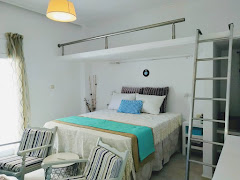OH.
MY.
GOD.
We ate everything: dakos rusk, marathopita, gardoumia (sheep's intestines wound round tripe - the little dark pieces are the animal's spleen), stamnagathi, tzatziki, fried potatoes, local sausage and roast lamb and potatoes (1 beer, 2 lemonades; 45 euro).
The taverna was non-descript; it didn't even have a discernible name, suffice it to say that it was located in the historical village of Therisso, about 15 minutes away from our house, and it was the second taverna on the right-hand side as you enter the village. We didn't find any tables in the first one, which is why we ended up here, but later, when we went for a walk in the upper part of the village, we found all the tavernas doing a booming trade. At the end of the meal, we were treated to a very good tsikoudia and some ravani cake.
Labour Day (one of the zillions of public holidays in Greece; in combination with regular strikes, it's a wonder Greeks get any work done at all) is associated with spring weather, village walks and flowers; Therisso has got it all. The village itself is a popular place for hiking, despite the rubbish and rubble that is left in full view of the tourists and local visitors coming to this verdant village. I suppose the locals don't need to care because they know that the visitors will just keep on coming, whether the road is full of somebody else's household garbage or not, especially now that a construction company has bought some prime land at the very entrance to the village - the end of the long gorge that separates the moutainside village from the rest of Hania - and turned it into brick-built houses which are going to be sold to British retirees (the new 'neighbourhood' has been given the name "The Maples" of all things). During the Labour Day holiday, it's traditional to collect flowers and make them into a garland, but we let all the other Greeks who'd piled into the village (access to it is via a very narrow road) do this and left the countryside in the same state that we found it in.
On our return journey back home, we passed a few picnickers, which was a delight to see. I don't know if it was the rising cost of living or the acquisition of Western customs that kept them away from the tavernas and frappe coffee bars.
©All Rights Reserved/Organically cooked. No part of this blog may be reproduced and/or copied by any means without prior consent from Maria Verivaki.
MORE RESTAURANTS:
AGORA
Therisso
London
Paleohora
Aroma

Καλη Πρωτομαγιά!!!
ReplyDeleteKalo Mhna Maria and I'm diggin' the Gardoumia!
ReplyDeleteI've already been dreaming about Dakos, and now I have to see it too! Therisso sounds intersting - I'd love to go to the museum. I read an analysis a couple years ago that the Battle of Crete was the turning point in World War II. Because the Cretans fought so fiercely, the Germans were delayed, throwing off their entire battle plan, plus it made them hesitant to use paratroopers since so many were slaughtered as they landed on Crete.
ReplyDelete